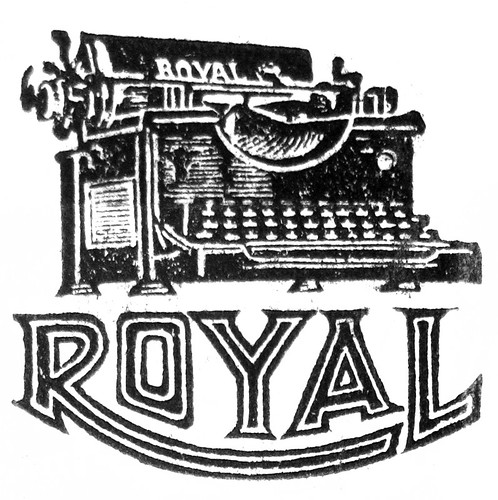- Uwe
- Moderator
 Offline
Offline 
- From: Toronto, Canada
- Registered: 12-3-2013
- Posts: 4,410
Re: Royals compared to other typewriters?
beak wrote:
Well now! 'For their standard line, Royal is king.' would be a debating topic...
Such sweeping statements are always amusing to read. Unless you've directly, and objectively, compared examples from every typewriter manufacturer that existed, and used pristine models tuned to factory specifications for that comparison, what exactly are such authoritative sounding declarations based on? The norm within our hobby is that opinions are usually formed from a limited - shockingly limited actually - experience with the myriad makes and models that were produced during a century of typewriter mass production. Arguably making matters worse, many of those opinions come from those who aren't even able to differentiate between a subjective and objective analysis of a machine's characteristics.
In the same breath I have to admit that I too have been guilty of making tongue-in-cheek declarations of one model's superiority over all others (typically when discussing the Olympia SG1 ![]() ) without bothering to properly qualify my statements. Even though I own and have used a large number of different standards, and include in my experience a career of writing professional comparisons of machinery for publication, I still don't consider myself qualified to declare any one typewriter (or typewriter manufacturer for that matter) as an undisputed King. In truth, I'm always pleasantly surprised by the fundamental parity that exists between the makes and models within my own collection, and by how efficient and effortless the majority of those machines are in their role of creating type.
) without bothering to properly qualify my statements. Even though I own and have used a large number of different standards, and include in my experience a career of writing professional comparisons of machinery for publication, I still don't consider myself qualified to declare any one typewriter (or typewriter manufacturer for that matter) as an undisputed King. In truth, I'm always pleasantly surprised by the fundamental parity that exists between the makes and models within my own collection, and by how efficient and effortless the majority of those machines are in their role of creating type.
The pronoun I has always been capitalized in the English language for more than 700 years.
- Uwe
- Moderator
 Offline
Offline 
- From: Toronto, Canada
- Registered: 12-3-2013
- Posts: 4,410
Re: Royals compared to other typewriters?
TypewriterGuy wrote:
I have never seen a hermes, olympia, or adler (Besides my 80s Royal TA) in person, so I would day that the Royal is King applies to the US.
And yet all of those other brands were also available and sold in the U.S., so should we surmise that you (and ztyper) are saying that Royal had no equal when only compared to Remington, Underwood and Smith-Corona? Even with such limited competition I don't think it's a defendable statement, certainly not without providing the criteria and results that allowed you to reach such a conclusion. Don't get me wrong, I really like Royal typewriters a lot too, and although it's fine to state that you prefer using your Royal models over whatever else you might have in your collection, in order to crown a company "King" in a forum filled with collectors you had better be able to back that claim up with some hard facts. ![]()
The pronoun I has always been capitalized in the English language for more than 700 years.
- ztyper
- Key Master
 Offline
Offline 
- From: Somewhere in New Jersey
- Registered: 01-10-2014
- Posts: 773
Re: Royals compared to other typewriters?
beak wrote:
Well now! 'For their standard line, Royal is king.' would be a debating topic on which I would rather be among the opposition to the motion!
That statement was supposed to be a bit of a pun 'cause, you know, kings are royal. (I'll see myself out...) ![]()
A high schooler with a lot of typewriters. That's pretty much about it.
- Uwe
- Moderator
 Offline
Offline 
- From: Toronto, Canada
- Registered: 12-3-2013
- Posts: 4,410
Re: Royals compared to other typewriters?
ztyper wrote:
That statement was supposed to be a bit of a pun 'cause, you know, kings are royal. (I'll see myself out...)
Turned out to be a bit of a Royal flush instead... (I'll see myself out now too...) ![]()
The pronoun I has always been capitalized in the English language for more than 700 years.
- beak
- Key Master
 Offline
Offline 
- From: Qld Australia
- Registered: 24-3-2013
- Posts: 929
Re: Royals compared to other typewriters?
Straight out the door with the pair of you!
Sincerely,
beak.
- Asher Black
- New Member
 Offline
Offline 
- From: Brooklyn NY
- Registered: 04-8-2015
- Posts: 21
Re: Royals compared to other typewriters?
M. Höhne wrote:
BTW, what do you mean by chiclet keys on a typewriter? Just the shape?
Well they remind me of molars. The "chicklet" keys are square and not thin but deep, like those on a Royal Sprite.
- from somewhere in Forest Park
- •
- Asher Black
- New Member
 Offline
Offline 
- From: Brooklyn NY
- Registered: 04-8-2015
- Posts: 21
Re: Royals compared to other typewriters?
Hmm. Well, I'll look at "office" models at some point then. The configuration of my typing table is such that the table is tall and the chair won't get tall enough, so the portables seemed right. I do have an Olivetti Studio 44 which is still considered a portable but is larger than the others I mentioned, and it's sloppier/looser (less tight feeling) than the Lettera 22 - the keys sort of feel spongy regardless of touch setting vs. the Lettera which, on the lightest touch feel snappy/firm. I went for the Lettera 22 (which I'm using almost exclusively) and the Groma (which I love but which must go in for service) because they are regarded as having "punchy" rather than sloppy action (these terms elude me a bit), and they are raved about by some authors - the 22 especially, because I honestly didn't know what I was doing until I got into it. Now I find my sloppiness fat fingering the smaller, roundish keys is displeasing (hence desire for "the fatter keys"), and yet I love the feel of these 2 machines otherwise.
- from somewhere in Forest Park
- •
- Asher Black
- New Member
 Offline
Offline 
- From: Brooklyn NY
- Registered: 04-8-2015
- Posts: 21
Re: Royals compared to other typewriters?
Thanks for all these notes. You guys are a bunch of enthusiasts for sure! Sorry - there's no "edit post" capability that I'm seeing or I'd consolidate thoughts. Thanks for all the replies. I think a Hermes 3000 could be my friend. It's sorta bigger, has chicklet keys (don't know the term) and people say it feels like butter (is that good?). I also considered the Skywriter and the Hermes Rocket (realizing that's smaller still) but these are probably also not all day typers.
- from somewhere in Forest Park
- •
- skywatcher
- Moderator
 Offline
Offline - From: The Prairies of Alberta
- Registered: 14-3-2013
- Posts: 742
Re: Royals compared to other typewriters?
Hi Asher
You are correct, we are a bunch of enthusiasts here on Typewriter Talk, that's why we hang out here![]() . When looking at typewriters for serious writing, one must also take into consideration the purpose for which the machine was designed. I'll use the Smith-Corona family as my example working from lightest to heaviest;
. When looking at typewriters for serious writing, one must also take into consideration the purpose for which the machine was designed. I'll use the Smith-Corona family as my example working from lightest to heaviest;
The Skyriter was built as a travel typewriter and was expected to type a few pages a week, while whom ever was using it was out on assignment or on holiday.
The 5-series (Sterling, Silent etc.) was a portable typewriter designed for home or office where it would be expected to type a few letters a day.
The Secretarial or 88 was a desk top typewriter designed for use in a lawyers office or similar where it would be expected to type a couple of letters or pages per hour.
The Super-Speed was the heavy-hauler of this family, designed as a typing pool machine where it would be in near constant use for 8 hours a day typing out a page every 5 minutes.
One could say the same about the Hermes Rocket, 3000, Ambassador and the big Hermes' heavy hitter (I believe it was the Hermes 9), but each level of machine is built for a different level of workload. The later Royals like the Sprite, although they have Royal printed on them, they were made in Japan by Silver-Saeko (now Saeko-Epson) in order to compete in the world market that was being flooded with cheap Japanese everything back in the late 1960's and 1970's. Hope this gives you a little to think on and a better idea of what qualities you are looking for in a typewriter.
As for the Olivetti 32, I too found the keys and especially the space bar too small for my big hands, so it became a late Christmas present for the 12 year old daughter of a friend. The shrieks of excitement when she realized what she was getting were priceless. All the best,
Sky
We humans go through many computers in our lives, but in their lives, typewriters go through many of us.
In that way, they’re like violins, like ancestral swords. So I use mine with honor and treat them with respect.
I try to leave them in better condition than I met them. I am not their first user, nor will I be their last.
Frederic S. Durbin. (Typewriter mania and the modern writer)
- TypewriterGuy
- Typewriter Talk Vet
 Offline
Offline 
- From: United States
- Registered: 24-4-2015
- Posts: 1,250
Re: Royals compared to other typewriters?
Whatever you do, I really would not get a skywriter.
They (For me) have horrible touch, keys get jammed if you're a fast typer, etc. Its because they are so small.
Back from a long break.
Starting fresh with my favorite typer. A Royal Futura!


